King's Road (Finland)
The King's Road (Finnish: Kuninkaantie, Swedish: Kungsvägen) is in Finland. Following the southern coast, this was once the most important road in the country, connecting Turku to Vyborg and the towns and villages between.
- This article is an itinerary.
Understand
- See also: Nordic history
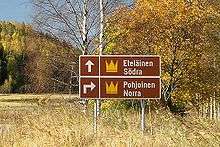
The King's Road was part of a medieval mail road that stretched from Bergen in today's Norway to Vyborg in today's Russia. The King's Road itself referred to the easternmost part of the route, eastwards from Turku. The part that connects Turku to Stockholm, across the archipelago and Åland, is known as the Great Mail Route (Fi. Suuri Postitie, Sw. Stora Postvägen)
In the Middle Ages, Finland was a part of the Swedish kingdom and the road was the primary route to the east not only for Swedish royalty, nobility and clergy, but also for armies and merchants. Old manors, churches, guesthouses, and some of Finland's oldest cities and towns are located along the route. In 1649 the route was formalized: this meant rules were instated for the traffic and maintenance of the road, in addition to the network of the inns and their services.
The King's Road was the main coastal route until the 1930s. By then, the responsibility for road maintenance had been transferred from local landowners to the state, tractors and other machinery for road construction had become available, and automobiles had begun replacing horses on the roads. This prompted expansion and improvement of the Finnish road network on a large scale, including the construction of a new road between Turku and Helsinki (now road 110, as it in turn was replaced by the current highway 1), which takes a more direct route.
As a legacy of the Swedish era, Finland has a Swedish-speaking minority, and a large population of them live in the areas along this road. Many of the cities and towns have both a Finnish and a Swedish name and, in a few places (mostly in western Uusimaa), the majority speaks Swedish. The names of places in this guide are given in the majority language in each municipality, as this always appears first on local road signs. If practical, the name in the other language is mentioned too.
Today the route is signposted from Turku along the Finnish southern coast all the way to the Russian border. The King's Road binds together notable buildings (and sites of notable buildings that don't exist anymore), town and cities from the 18th century and earlier. As you travel along this route, you can learn a lot about daily life in the bygone centuries. Not only are the buildings and environments there to admire, but there are also many museums and a variety of history-themed events that take place during the summer months. Much of the original route is still in use or at least accessible, but some of the original route has become buildings, forest, or something else. In the itinerary below, the missing parts are filled in with the straightest route.
Prepare
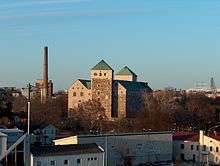
There is no need for any special preparations. The roads are in good or decent condition and services such as filling stations, restaurants and hotels don't have great distances between them. All that is needed is a map and some money. Depending on how you intend to travel, you may find our tips for cycle trips, tips for motorcycle trips, and/or tips for road trips useful.
All sights along this route can be seen at all times of the day and the year — from the outside, that is. Churches are open to the public during daytime, year round with services on Sundays and Christian holidays. Of the manors you will pass, some are private residences or educational institutions and not open to the public. However, many are museums, premises for outdoor activities like horse riding or golf, or just hotels or restaurants. The former ironworks have been converted to museums and are often venues for cultural events. As a rule of thumb, museums are open Tu–Su 10–17 and charge a couple of euros for entrance. Outside the summer months (June–August), museums and activities operate shorter hours, if at all. This is especially true outside large cities.
While not required, reading a little about Finnish, Swedish, and Russian history may help you get the most out of this trip.
Get in
If you want to start your trip from an end of this road, Turku is easily the better alternative. It has an international airport and regular ferries from Stockholm and better opportunities to rent a car or bike if you haven't brought one.
If you're arriving from Russia and have your own vehicle, you can equally well start at the eastern end of the route.
Helsinki is basically located at the mid-point of this itinerary, so starting your trip there would mean some additional going back and forth if you want to travel along the whole route.
Go
Car, motorcycle, or bike are the most common ways of traveling along this route. The full distance from Turku to Vaalimaa is about 400 km (about 250 miles), not including the sidetrips that are mentioned. You could do this trip by car in one day, though for serious sightseeing you should budget 2–3 days (or more if you're also interested in more modern attractions along the road). By bike the whole itinerary would probably take at least a week. The terrain is rather flat, but there are many interesting things to see.
This guide concerns itself with historical sites that are directly related to the route and/or showcasing life a couple of centuries ago such as inns, manors, churches and other buildings as well as museums. For the sake of completeness, some buildings that no more exist are name-dropped. The cities and towns along the road also offer more modern attractions, but those are listed in their appropriate destination guides.
Turku to Pojo
🌍 Turku (Swedish: Åbo) was the largest and most important city in Finland during the Swedish era. It is the western end of the road and has many interesting historical buildings, despite being badly destroyed in the great fire of 1827. According to some sources, the road would start at the old city hall; according to others, it starts at the medieval castle. Located right at the harbour where the ferries from Stockholm arrive and being the administrative centre of Sweden's "Eastland" (today's Finland and Estonia) in medieval times, the castle is obviously the place to start or end a trip along the King's Road. Leaving Turku you will pass 🌍 Ryövärinvaha ("Robbers' rock"). 🌍 Kaarina (Swedish: S:t Karins) is the next city on the route.
Kuusisto island (Swedish: Kustö) isn't on the route, but rather a sidetrip of a few kilometres. Here you can find the 🌍 Kuusisto castle ruins, a medieval episcopal castle that was demolished when Lutheranism was made the state religion. Nearby is Kuusisto manor, which functioned as the farm for the castle and later as a residence for high-ranking governmental officials. Next to the King's Road you can find 🌍 Tuorla manor (Tuorlan Kartano), another former farm for the castle. Today the main building functions as a hotel and restaurant and the rest of the premises hosts a trade school for farming and gardening. 🌍 Runko Inn (Rungon kestikievari), next to the road, is one of the road's many accommodations which no longer exist.
You can take a small sidetrip up to 🌍 Pukkila Manor Museum (Buckila), though as of July 2015 it seems to be closed. A café has opened there in 2018. Next the road goes through the town of Piikkiö (Swedish: Pikis), with 🌍 Piikkiö church as the main attraction. The current church only dates back to 1755, though. Similarily 🌍 St. Michael church together with its 🌍 clergy house are the main attractions of the next town on the road, Paimio (Swedish: Pemar).
The next roadside inn, Trömperi, actually has something to offer. It hosts the 🌍 Trömperi Inn Museum. During the summer the café is open and sheep wander around in the yard. You've entered the former municipality of Halikko, already a commercial centre during the Iron Age. Before Halikko, you'll pass through the village of 🌍 Häntälä, which existed in the 13th century as a large farm and one of great importance: not only did it have one of the road's inns but also a courthouse. Just before arriving in Halikko, you will cross Halikko river. There has been a bridge at least since 1626, when the town was heavily fined for keeping the bridge in a lousy state. The current highway bridge is of course much newer, but next to it there's a wooden bridge from 1865, passable by foot or bike.
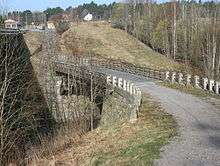
Halikko's surroundings offer quite a few historical sights; in addition to a 🌍 medieval granite church, there is also the 🌍 Åminne (Joensuu), 🌍 Wiurila (featuring a restaurant, a few hotel rooms, a carriage museum, an art exhibition and a golf course) and 🌍 Vuorentaka manors. Another inn was located at the lands of Åminne manor — 🌍 Majala Inn (Majalan Krouvi). Further south, there's also the 🌍 Rikala fortress hill, the ruins of an Iron Age fort.
You will pass through neighbouring 🌍 Salo, which Halikko is administratively part of. At the southern edge of the city, you will pass near the 🌍 Uskela church, on the top of Lukkarinmäki hill. While the current building has only been there since 1832, this was the site of the Chapel of St. Anna dating from the middle ages. Around the hill you can find interesting wooden architecture from the same period, forming a suburb to Salo. About a kilometre and a half south-east there's yet another medieval fortress hill, 🌍 Hakostaro. Somewhere near the latter functioned an inn.
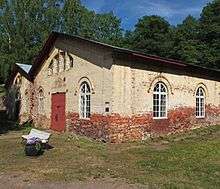
Following the coast, the route continues south along the current highway 52, the next town being Perniö (Swedish: Bjärnå). The route goes through the farming landscape of the Perniö River valley which, like the King's Road itself, has been given the status of "Nationally Remarkable Built-up Cultural Environment" by the Finnish National Board of Antiquities. In Perniö, historical sights include the 🌍 church and the clergy house and at the other bank of Kisko River, the Haarla manor and former inn. You're now entering the region which was the centre of Finnish iron industry from Swedish times until the early 20th century. The road will pass near several historical ironworks, one of which is in 🌍 Matildedal. Visiting entails a sidetrip to the north-west (though there are still others further east the King's Road).
Two major manors follow, 🌍 Latokartano and 🌍 Olsböle. The latter features a well-preserved inn building from the 1830s. By now you've entered the province of Uusimaa (Swedish: Nyland). The route turns off inland just north of the small town of Tenala, so visiting its 🌍 medieval church means a minor sidetrip. Just before entering Pojo (Finnish: Pohja) you can see the 🌍 Klaus Fleming memorial (Fleminginkivi) on the place where Klaus Fleming, the governor general of today's Finland and Estonia, died one night in 1597 during a journey to Perniö. 🌍 Pojo itself offers yet another 🌍 church. To go east from Pojo there are two options, a more southernly route along the coast or a more northernly inland route.
Pojo to Siuntio, southern fork
|
King's Road glossary Finnish/Swedish
|
The route passes two former ironworks, 🌍 Åminnefors and 🌍 Billnäs. The former is much younger and there's still industrial activity on the premises, Billnäs, on the other hand, has a history from the 17th century and is now a museum and site for cultural events, many of them history themed. It also features a beautiful avenue (Billnäs allén) and wooden architecture.
Continuing along the route, you'll pass through the town of Karis (Finnish: Karjaa). Continue a bit towards Ekenäs and Hangö — both worth considering as sidetrips — before going south towards 🌍 Snappertuna. Just south of this village is 🌍 Raseborg castle or rather its well-preserved ruins. Intended as a rival to Tallinn, the castle was fought over several times during its 15th century heyday. Today Raseborg isn't the metropolis its planners hoped it would become, but at least the castle has given the name to the municipality consisting of the towns of Pojo, Karis, and Ekenäs.
The road continues to the village of 🌍 Fagervik, and the stretch of the road just before the village is one of 22 routes in Finland to have been given "museum road" status by the Road Administration. Fagervik literally translates to "beautiful bay" and the former ironworks located here were once the largest in Finland. The industrial premises with the worker's housing, the manor, and the village church are well preserved. For a maritime break, make a detour down into the 🌍 Barösund archipelago.
Your next destination is 🌍 Ingå (Finnish: Inkoo). In its medieval church you can see Finland's only preserved Danse Macabre-themed fresco. The following village is the picturesque 🌍 Degerby. Traveling across the fields you will pass the former hamlet of 🌍 Billskog, where a roadside inn once existed. At the road junction in 🌍 Sunnanvik the both forks of the King's Road join together. If you've taken the southern route, you may want to backtrack up to Siuntio (Swedish: Sjundeå) for the sights described in the northern fork section below.
Pojo to Siuntio, northern fork
This fork of the King's Road include several ironworks, starting with 🌍 Fiskars. Unlike the other ironworks that at best have been turned into outdoor museums, Fiskars is a large corporation with some 3600 employees producing tools and household equipment from the iconic orange scissors to axes and knives in factories both near Fiskars village and in other countries. This doesn't mean that there's nothing historical to see here, quite the contrary! The village of Fiskars is also known for the cultural festival "Faces", taking place each summer.
The road from here travels along highway 104 towards Karjalohja, passing the former 🌍 Antskog ironworks (nowadays just a small village) and then 186 southeast. Another route to take leads back south to Karis and, from there, along highway 25.
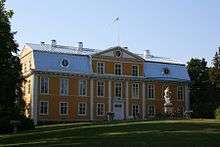
No matter which route you choose to travel, the next point of interest is Svartå (Finnish: Mustio). This village is probably best known for its 🌍 manor, which is so grand that it's known as a "castle" in Swedish and Finnish. It is another of the few King's Road attractions you can actually sleep in (it'd certainly fall in the Splurge category, though). At the other bank of the river lies the Svartå 🌍 ironworks.
Leaving the ironworks behind, the route passes near the 🌍 Kirkniemi manor, which is off the signposted road. If you still would like to see some industrial heritage, though just dating a century back, take a detour to 🌍 Tytyri calcite mine with its mining museum located underground.
🌍 Siuntio, or nowadays the "Siuntio church village" features the next medieval church on the route as well as 🌍 Suitia Manor. The manor was first mentioned in the 15th century, but has been rebuilt and expanded several times and with its stepped gables you may believe you're in Riga or Northern Germany. Continuing south through the "Siuntio station village", the modern town centre, you will go next to 🌍 Fanjunkars, the residence of 19th century author Aleksis Kivi. The 17th century 🌍 Sjundby manor, on the other hand is not on the signposted route, but most certainly worth the 2 km sidetrip. From Siuntio there are a few kilometers south to Sunnanvik where route joins with the southern fork.
Siuntio to Vantaa
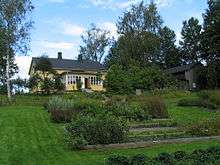
Passing the farms of Sköldvik and Rånäs, your journey takes you to Pikkala, formerly an important trade centre with vendors from Ekenäs and Helsinki. The 🌍 old bridge can today be crossed by bike or foot, anything heavier will need to use the highway bridge a kilometre south. 🌍 Pikkala manor is another nearby sight.
The next landmarks are the 🌍 Överby manor, which formerly hosted an inn and is now a gardening school, and 🌍 Ragvalds farm which is now a farming museum. Passing central 🌍 Kirkkonummi (Swedish: Kyrkslätt), you will notice the church looks a bit different from the ones seen previously along the route. It was probably first built in the early 15th century but has been both rebuilt and destroyed several times over. The last time it was destroyed occurred during the decade after WW2 when most of Kirkkonummi and neighboring areas were leased to the Soviet Navy (this period was known as the Porkkala Parenthesis).
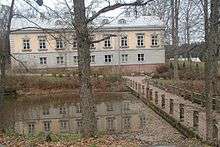
Further along the route you will pass near the hamlet of 🌍 Sundsberg, which formerly had an impressive manor, though it was demolished in the 1950s due to its bad condition. From here, there are just a few kilometers until you arrive at 🌍 Espoo manor. You will cross Mankki river (Mankinjoki) on two of the oldest road bridges still in use in Finland; Sågbron and Espoonkartanonsilta.
Next, the King's Road passes through 🌍 Kauklahti. Inhabited as early as 4000 BC, it was an important trading site in pre-Swedish times but today it's just another district of the city of Espoo.
In the Capital region there is relatively little to see when it comes to the King's Road, and the road isn't as well marked as it is to the west and east. 🌍 Espoo (Swedish: Esbo) does have a medieval church which also is the seat of the Diocese of Espoo. It's located in a park which is surrounded by commercial and residential buildings on all sides.
After crossing the Helsinki–Turku freeway, you should arrive in the village of Bemböle, and this is a good place for to take a break. Here you can find 🌍 Bemböle kaffestuga, one of the former inns that functions as a café. Across the river you can visit the 🌍 Glims Farmstead museum that showcases a life on a farm in the 18th century.
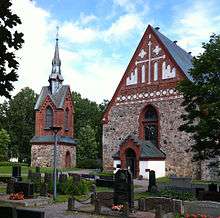
The next manor on the route is 🌍 Träskända manor, literally "lake's end". There's no surprises here, it is indeed located at the end of Pitkäjärvi/Långträsk. It's surrounded by several parks and actually much younger than most other manors along the route. The current main building only dates from the 1920s! From here to Vantaa you can follow the beltway or streets that run next to it — the road isn't really marked well here. If you're interested in traditional farming, the next two sites are worth checking out. Near Vantaa river, you can make a short sidetrip to the 🌍 Vantaa Farming museum if you want to see some more traditional farming equipment. Travel further and you'll arrive at 🌍 Backas manor. Founded in the 17th century, it's known by locals for its pre-WW2 role as the main farm of the now-defunct consumer cooperative Elanto.
Vantaa (Swedish: Vanda) was formerly known as Helsinge and, as mentioned below, this 200 years older settlement actually gave name to Helsinki. The 🌍 medieval church together with the surrounding village of wooden homes is probably one of the highlights of the route in the capital region. If you feel it's time for a break, head to the Kahvitupa Laurentius, a coffee house at yard outside the church. Continuing through Tikkurila, the attractions and architecture are again exclusively of the modern type, though the landscape gradually gets more rural again. The name of the road — Vanha Porvoontie/Gamla Borgåvägen, reveals that you're nearing Porvoo which is one of the highlights of this trip.
Helsinki
Another fork of the road passes through Helsinki, but before it was made capital of the Grand Duchy of Finland in 1812, Helsinki wasn't an important city, even on a regional scale. This fork of the road isn't signposted and doesn't even take you to the current downtown of Helsinki. From Bemböle, follow either highway 110 or freeway 1 until they end in northwestern Helsinki, continue along Hakamäentie past Pasila and to 🌍 Vanhankaupunginkoski (the rapids of Vantaa river into Vanhankaupunginlahti, a bay of the Bay of Finland). This was where Helsinki originally was located, though there's little to see today. From there, continue north along the road running parallel to freeway 4. After some 15 km, near the 🌍 Honkanummi cemetery you'll catch up with the more official King's Road again.
Vantaa to Vaalimaa
Entering Eastern Uusimaa, 🌍 Sipoo (Swedish: Sibbo) is the next town on the road. Remarkable buildings near the municipal centre of Nikkilä (Swedish: Nickby) include 🌍 Båskis manor and former inn and the city's 🌍 old medieval stone church — and why not the 19th century "new church" as well? Just outside the town, there's the 🌍 Savijärvi manor. The border to Porvoo is marked by 🌍 Götstenen, the boundary marker since the 16th century.
There are several manors along or near the route from this point. 🌍 Boe manor, also known as Högvalla manor is located near the village of Hinthaara and is also one of the manors you can sleep in. 🌍 Drägsby manor entails a detour along the Mustijoki river and is another relatively new manor built on the place of a medieval one. If you want to extend the sidetrip you can travel down to the sea and see 🌍 Haikko manor, another destination offering accommodation. Entering Porvoo, in the 🌍 Näsi district you can visit Näsi manor and the landmark Näsi stone. Cross the river — do it the traditional way across the 🌍 old bridge — and you are in the old town of 🌍 Porvoo.
Porvoo is the second oldest city in Finland. It is an old town only rivalled by world heritage listed Rauma and is definitely one of the jewels along the King's Road. Highlights include the cathedral towering above the town, the red riverside storehouses, the former town hall, and the many alleys with the iconic wooden houses. You can stroll along the river and explore the 🌍 fortress ruins on Linnanmäki.
Leaving Porvoo behind, 🌍 Postimäki is the next point of interest. A roadside in used to be located here, in the village of Ilola. In 1638 when the mail route along the King's Road was formalized, an important post office was established giving the area its current name — "Post Hill". Today it is an open air museum and a site of cultural events during the summer.
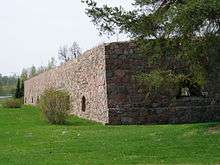
In the village of Koskenkylä, next to the rapids, there's an 17th century 🌍 ironworks. Downstream is a former 🌍 silver mine that was part of the complex. Pernaja (Swedish: Pernå), the next town on the road, has a 🌍 medieval stone church. You may notice by now that it has a similar red-tile pattern at the gable that all the medieval churches mentioned in this itinerary have since Espoo. All of these churches have been designed by an unnamed 15th century architect known only as the "Master of Pernaja". Somewhere at the other side of the road you could once eat and sleep at the Baijars inn. Halfway to Loviisa you will pass near the baroque 🌍 Storsarvlax manor, probably one of the most impressive manors along the road.
Arriving in 🌍 Loviisa (Swedish: Lovisa), you may believe the road is leading straight into the wall of the town's neo-Gothic church. It was built in 1865, after the old burned down. From here, you'll cross the picturesque downtown. Loviisa's oldest standing house, 🌍 Degerby Gille used to be an inn but now hosts a restaurant. It only operates upon prior request for parties, conferences, and such events. At the eastern edge of town you'll pass the 🌍 Loviisa fortress consisting of the bastions of Rosen and Ungern. There's also an island fortress, 🌍 Svartholma fortress, accessible by ferry in the summer, which makes for a nice maritime sidetrip. After Loviisa you'll pass the village of 🌍 Myllykylä, where the following inn was located.
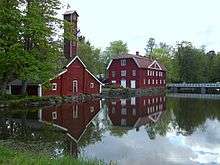
The route crosses Kymi river (Swedish: Kymmene älv), one of the largest rivers in Southern Finland. The western major branch of Kymi is crossed at 🌍 Ahvenkoski, best known for its hydroelectric plant. Between 1743 and 1809 Kymi formed the border between Sweden and Russia, testament to this legacy are the remains of the bastions on both sides of the border. Today the river simply marks the border between the regions of Uusimaa and Kymenlaakso (Swedish: Kymmenedalen) and is crossed by both a highway bridge and a brand new freeway bridge. If you're on biking or walking you can use the even older bridge, a few hundred meters northeast, though dating from 1927 it's not particularly old. But before crossing, the 🌍 Strömfors ironworks in Ruotsinpyhtää can be an interesting side trip.
East of the river is the town of 🌍 Pyhtää (Swedish: Pyttis) where the main sight — of course — is the medieval church. After this you'll pass through the northern suburbs of 🌍 Kotka, itself on an peninsula jutting out well into the Gulf of Finland. You'll pass the eastern delta of Kymi river here, featuring some rather impressive rapids for southern Finland, as well as the next manor on the route 🌍 Kyminkartano or Kymi Manor. The original manor was constructed around 1350 and was located to the south across the Kymi river. Today, the site holds the 18th century Russian-built 🌍 Kyminlinna fortification. Also worth visiting, though off the route and from a little later period, is the 🌍 Imperial fishing lodge at Langinkoski, built in the late 19th century for the Russian czar.
|
18th-century traffic rules
At that time there was left-hand traffic on the road, just like elsewhere in Sweden. |
The route passes through the village of 🌍 Neuvoton, which translates to "clueless" in Finnish. The village name was not invented as a joke, but has evolved out of Nefitte, which was the name the Hansa traders called it. They came to Neuvoton and nearby Saksala (lit. "German place") to buy fish to sell in Tallinn. Before arriving in Hamina, you'll pass 🌍 Summa manor, 🌍 Poitsila manor and 🌍 Salmi bridge, which is listed as a museum bridge.
🌍 Hamina (Swedish: Fredrikshamn) is the last city on the route and is known for its circular town plan, a concept used in Italian Renaissance fortresses as well as for its fortification walls. The city was founded by the Swedes in 1721 as an outpost against Russia, who at that time just had conquered Vyborg. The 18th and 19th century Hamina is well-preserved and it's still a military city today, hosting the Reserve Officer School.
From Hamina eastwards the route is designated a 🌍 museum route, just like the part in Fagervik in Ingå. A fun fact is that while the one in Ingå is the shortest of the 22 "museum"-designated routes in Finland, this is at a length of 35.2 km the longest. 🌍 Vilniemi manor requires a sidetrip, as it's a bit off the road. The next landmarks on the road are the 🌍 Pistol stones (Pistoolikivet); these are two giant stone blocks on each side of the road behind which highwaymen allegedly used to hide while awaiting someone to rob.
Slightly off the road lies the 🌍 Harju Manor, which is probably one of the youngest manors on the King's Road. It hosts a vocational school and also offers accommodation. In the area you will find much newer fortifications, namely the Salpa Line constructed during WW2 — you're nearing the border to Russia. This is not the first time in history there has been a border here, the Swedish-Russian border after the Peace of Nystad (1721) are marked by stones in the terrain, for instance 🌍 Alapihlajan kivi and 🌍 Kirkkotien kivi and a larger cluster of stones around the 🌍 Virolahti church. Continue north to Virolahti (Swedish: Vederlax) and 🌍 Vaalimaa border, where the signposted King's Road ends.
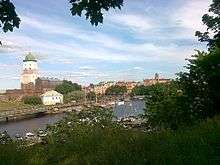
Onwards to Vyborg
The end of the historical King's Road road is 🌍 Vyborg, which was the second city of Finland during the period of Swedish rule and an important cultural centre up to the Second World War. Being in Russia nowadays, visitors from most countries need a visa. Across the border the King's Road likely isn't signposted in any way, so just follow the main highway E18 for about 40km. Like Turku, Vyborg also features a 13th-century castle and old buildings, though due to bombings and battles during World War II and subsequent neglect they're not in very good condition.
Eat
Some of the manors and other attractions along the road have a café or a restaurant, but not all of them. The very few places that formerly have functioned as inns and still operate as cafés are denoted by orange markers in the above itinerary. Other than this, you can find someplace to eat in all towns and cities along the route and when the route goes along modern highways you'll have no problems finding cafés or basic restaurants (often adjacent to gas stations). Perhaps these could be considered the modern day equivalent to roadside inns.
Sleep
Unfortunately, the old inns that served travelers are no longer in operation, though a few do operate a café or a restaurant. The closest thing to "King's Road" accommodation are some of the manor houses that function as — mostly upscale — hotels. These are indicated by dark blue markers on the above itinerary. For smaller travel budgets, most towns along the road have at least one hotel or B&B. A wider selection of accommodation can be found in Turku, Salo, Espoo, Helsinki, Vantaa, Porvoo and Kotka.
Stay safe
- See also: Finland#Stay safe
Finland is among Europe's safest countries and you don't need to worry about crime. Traffic is low on most of the roads in this itinerary, so there is also little risk for accidents. By far the best time to travel is during the summer, though should you still opt to travel during the winter months, do have a look at the winter driving article. Another risk on the road throughout the year is crashing into moose and deer that may appear on the road in the countryside. Occasionally there are also horse riders, which you should leave at safe distance.
Go next
From Vaalimaa
- Vyborg, as mentioned above — note that visitors of most nationalities must have a visa to enter Russia. Alternatively there are visa-free cruises from Lappeenranta (about 70 km to the north) to Vyborg along the Saimaa Canal during the summer months. To participate in those you cannot just show up before the sailing, you need to book the cruise and e-mail the ferry company a scan of your passport at least a couple of days ahead.
- Lappeenranta itself also has a Swedish-built fortification from the 17th century. For a medieval castle, continue a further 150 km to Savonlinna.
From Turku
- Westwards the historical route is known as the Great Mail Route and hops from island to island to Åland and further on to Sweden. There is a yearly competition, Postrodden, in memory of the mail route over the Sea of Åland, between Eckerö and Norrtälje.
- Finland's third oldest town, Rauma with its world heritage listed wooden old town is also an alternative. It is about 100 km north of Turku.